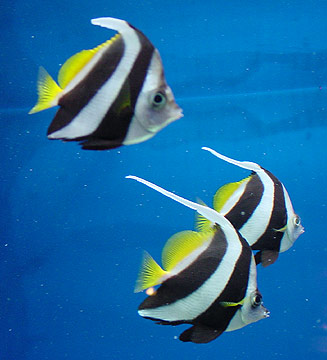Peacock Cichlid

|
Scientific Name: Cichla ocellaris Price: Upon Request Origin: South America Family: Cichlidae NOT AVAILABLE NOW |
|
Other Names: Peacock Bass, Tucunarč, Lukanani, Butterfly Peacock Bass, Eye Spot Cichlid, Cichla ocellaris, Cichla sp, |
|
Technical Info
Temperature: 24 - 27 ℃
pH: 6.5 - 7.5
GH: 6 - 16
Max size: 75 cm
Min Tank size: 1000 Ltr
Position in Aqua: No special swimming level
Description
The Peacock Cichlid has an elongated deep body. The back is silver-gray and marked with three, broad transverse stripes. The lower parts are yellow to gold, with a region marked with black splotches. Just below the yellow area is an orange-red region, which also parallels the white belly. The second part of the dorsal fin has white spots, and those spots are also found on the top part of the tail fin. The mouth is very large and faces towards the surface. The pelvic, anal, and caudal fins are orange-red, and the dorsal fin is black. An obvious, black eye-spot can be found on the caudal fin near the caudal penuncle. Older males have a nuchal hump; otherwise the sexes are only distinguishable during the spawning act.
Food
A carnivorous fish that will accept most meaty foods. In captivity feed it a stable diet of shrimp, earthworms, mealworms, crickets, wingless fruit flies, bloodworm and tubifex. It should also accept high quality Cichlid pellets. Try to avoid feeder fish, especially Goldfish, as well as dietary problems, it can also turn the fish so it will only accept live foods and will ignore pellets and dead food.
Breeding
No reports of successful spawns in aquaria. In nature, as many as 10,000 eggs are laid in circular nest that are dug in the muddy shallows during the rainy season. The parents are excellent, caring for the young for four weeks, at which time they are 5 cm, and the female is chased off by the male.
Compatible with
Territorial and moderately aggressive. Can be kept in species groups or with other large species such as arowana, stingrays, large cats and other large cichlids. An extremely large tank is required to achieve this with any degree of success.
Note
Due to their large size, Peacock Cichlids are only really recommended for the experienced fishkeeper that can house them adequately. That said, they are a hardy and robust species that will adapt to a variety of conditions.

